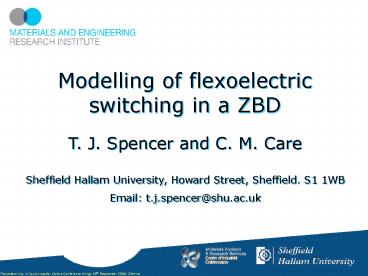Modelling of flexoelectric switching in a ZBD PowerPoint PPT Presentation
1 / 16
Title: Modelling of flexoelectric switching in a ZBD
1
Modelling of flexoelectric switching in a ZBD
T. J. Spencer and C. M. Care
Sheffield Hallam University, Howard Street,
Sheffield. S1 1WB
Email t.j.spencer_at_shu.ac.uk
Flexoelectricity in liquid crystals Oxford
Conference thingy 19th September 2006 20mins
2
Aims
- To investigate flexoelectric coefficients e11 and
e33 in an LCD through simulation in order to gain
insight into their magnitude, sign and behaviour. - Show that the ZBD is an ideal tool for the
exploration of e11 and e33 as this device may be
latched in terms of the flexoelectric coupling to
an applied electric field. - To give insights to the ZBD technology.
3
The ZBD technology
- A grating shaped surface can impart bistability
in an LCD. - Dark state is essentially vertical and defect
free (continuous state C). - Light state is hybrid aligned with a pair of ½
defects at the grating surface (defect state
D). - Flexoelectric effect couples to an applied field
in order to latch between the two states.
one pixel
O (V)
5 mm
ms
V
ms
V
J.C.Jones, S.Beldon, P.Brett, M.Francis,
M.Goulding, Low voltage zenithal bistable
devices with operating windows, SID Symposium
Digest of technical papers 34, 954 (2003).
4
C state director configuration
5
D state director configuration
-½ defect
½ defect
6
How does it latch? D to C
See http//www.maths.strath.ac.uk/research/liquidc
rystals/Rank2004/Spencer.ppt 2004.
7
How does it latch? C to D
See http//www.maths.strath.ac.uk/research/liquidc
rystals/Rank2004/Spencer.ppt 2004.
8
Method
- Simulation of a full ZBD device.
- Simulation of realistic reference surface shape.
- Simulation of full LC mixture ZLI2293 / 5CB.
- Assumptions
- No ions (zero ionic terms).
- No fluid velocity (i.e. rotational dynamics only
zero viscous terms). - No uniaxial core effects (ignore terms).
- Method details see http//arxiv.org/abs/cond-mat/
0602421
9
Definitions
Type of cell geometry
Type of flexoelctricity
h1/8 173.258 x 10-3
,
A5 194.264 x 10-6
w1/3 8.879 x 10-3
- R. B. Meyer. Piezoelectric effects in liquid
crystals. Phys. Rev. Lett.,22(18)918-921, May
1969.
esurf
- G. Barbero and L. R. Evangelista. An elementary
course on the continuum theory for nematic liquid
crystals. World Scientific, 2001.
- G. P. Bryan-Brown, C. V. Brown, and J. C. Jones,
U.S Patent No. 6,249,332 (2001).
10
The experiment results
Mono-polar pulse
Bi-polar pulse
J.C.Jones, S.Beldon, P.Brett, M.Francis,
M.Goulding, Low voltage zenithal bistable
devices with operating windows, SID Symposium
Digest of technical papers 34, 954 (2003).
These latching polarities are maintained for
all liquid crystal materials studied, and
regardless of cell configuration
11
Recovering the tV curve and surface effects
12
Table of e11, e33 space
For the majority of grating shapes
No latching
Yes Latching
No latching
13
Does a change in flexoelectric coefficient alter
the voltages?
- Changing the flexoelectric coefficients is more
sensitive in the C to D transition. - Increasing the flexoelectric coefficients e11
and e33 generally reduces the threshold
voltages. - e33 has a bigger influence on the thresholds than
e11.
14
Does a change in flexoelectric coefficient alter
tV shape?
15
Conclusions
- ZBD technology is good to test material
parameters in particular flexoelectric
parameters. - Correct simulation methods are a useful probe to
these parameters. - e11 , e33 . Probably for most LC materials.
The phase space needs examining at much closer
intervals. - e33 more responsive then e11 in the ZBD in terms
of voltage thresholds. - e33 does not effect tV curve shape it shifts
the curve. - Weak anchoring does not change the results. But
it does shift the tV curve for one transition and
alter the steepness for the other.
16
Acknowledgements
- Prof Chris Care
- Dr Rich Amos
- Dr Cliff Jones
- ZBD Displays Ltd.
- DTI

